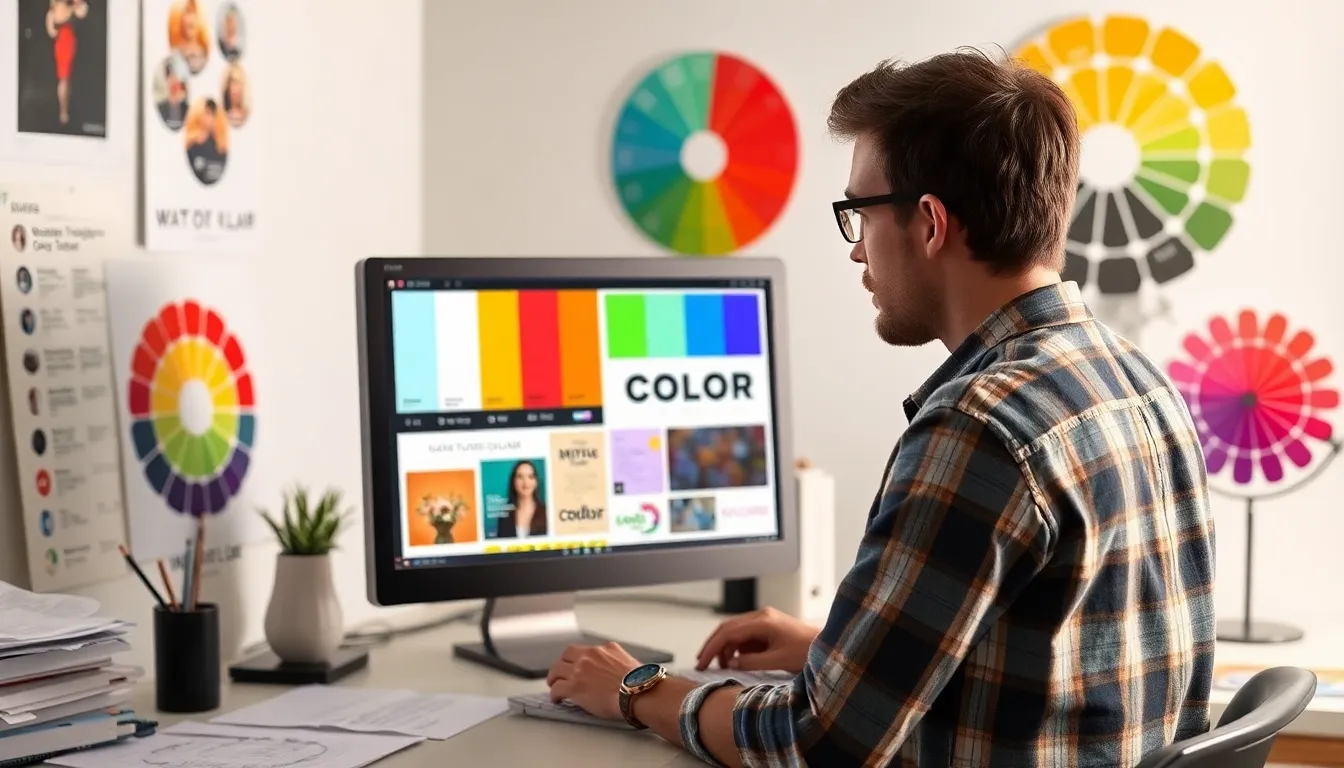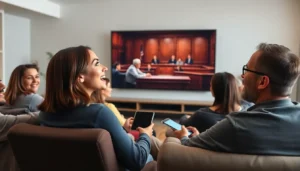Table of Contents
ToggleVisual design isn’t just about slapping pretty pictures on a page; it’s a vibrant spectrum that brings ideas to life. From the minimalist elegance of Scandinavian design to the bold chaos of street art, the visual design spectrum covers it all. It’s like a buffet where every dish has its unique flavor, and everyone’s invited to feast on creativity.
Overview of Visual Design Spectrum
Visual design encompasses an extensive array of elements and styles that contribute to effective communication. It combines creativity and functionality to enhance user experiences across various media. Techniques in visual design include typography, color theory, layout, and imagery, each serving specific purposes.
Types of visual design include graphic design, web design, product design, and motion graphics. Graphic design focuses on visual content for print and digital media. Web design integrates usability principles to develop engaging online experiences. Product design emphasizes user-centered functionality and aesthetic appeal. Motion graphics involve animated elements designed to convey information dynamically.
Color plays a significant role in visual design. Designers utilize color palettes to evoke emotions or establish brand identity. For instance, blue commonly signifies trust, while red can evoke excitement. Typography helps to establish tone and hierarchy, with font choices influencing readability and user perception.
Layouts guide the viewer’s eye and improve navigation. Grids and balance ensure content is organized, but asymmetry can create visual interest. Imagery, whether photographs or illustrations, enhances storytelling and complements the textual content.
Understanding the visual design spectrum involves recognizing how these elements interact. Each aspect contributes to the overall user experience, making it essential for designers to integrate them thoughtfully. By exploring the full breadth of visual design, one can appreciate the harmonious connection between form and function.
Key Elements of Visual Design

Visual design incorporates several key elements that significantly enhance communication effectiveness.
Color Theory
Color theory consists of various principles that guide the use of colors when designing. Color affects emotions and perceptions. Designers choose colors based on their psychological impact and cultural significance. For instance, blue often invokes trust, while red can evoke passion. Combining colors effectively can create a desired atmosphere in design. The color wheel assists in understanding complementary and analogous color schemes, which aid in crafting visually appealing palettes. Additionally, awareness of color contrast ensures text is readable against backgrounds. The role of color in branding cannot be overstated, as consistent color usage aids in establishing brand identity.
Typography
Typography involves the art and technique of arranging text in a visually appealing manner. It impacts readability and user experience significantly. Different fonts convey different moods: serif fonts often evoke tradition and reliability, while sans-serif fonts appear modern and clean. Adjusting font size and weight helps establish hierarchy, guiding users through content. Various line spacings, letter spacings, and alignment choices further enhance the text layout. Accessibility considerations matter; designers ensure that font choices cater to diverse audiences. Uniform typography across a project contributes to a cohesive design, reinforcing brand identity and aiding in effective communication.
Layout and Composition
Effective layout and composition form the backbone of visual design. These elements influence how users interact with content. Grids provide structure and balance, allowing designers to organize information systematically. Strategic placement of visual elements directs viewer focus, ensuring important aspects capture attention first. White space, often overlooked, enhances clarity by preventing clutter. Designers consider flow and rhythm to facilitate navigation throughout the design. Cohesive alignment of text and imagery fosters a harmonious experience, guiding users seamlessly from one section to another. Overall, thoughtful layout contributes to the overall effectiveness of visual communication.
Importance of Visual Design in Communication
Visual design plays a crucial role in effective communication. It simplifies complex information, making it accessible and engaging for diverse audiences. The combination of color, typography, and layout can significantly alter perception. Each design choice influences emotions and reactions, driving audience engagement.
Color theory impacts how messages are interpreted. For instance, blue often instills trust, while red can evoke urgency. Designers leverage these color associations to reinforce brand identity and enhance emotional connections with viewers. Optimal color choices can elevate a message’s impact dramatically.
Typography also contributes to visual communication. The selection of typefaces shapes readability and influences the tone of the message. Serif fonts may convey tradition and reliability, whereas sans-serif fonts typically suggest modernity and simplicity. A thoughtful approach to typography ensures that written content aligns with the overall design narrative.
Layout and composition facilitate user interaction with content. Strategic placement of elements guides the viewer’s eye and highlights key messages. Effective layouts improve navigation, ensuring that users engage with information seamlessly. Intuitive design minimizes cognitive load, enhancing comprehension and retention.
Visual design ultimately connects form and function. It amalgamates artistic expression with practical application, creating a cohesive experience for users. Particularly in our visually driven world, strong visual design elevates communication, ensuring messages are not just seen but felt. Each element contributes to a unified whole, enhancing overall effectiveness.
Trends in Visual Design Spectrum
Current trends in visual design showcase innovative approaches that continually influence digital and print media. Two prominent themes are minimalism and maximum contrast.
Minimalism
Minimalism emphasizes simplicity by stripping away unnecessary elements. Clean lines, ample white space, and a limited color palette characterize this style. Products and websites using minimalism enhance user experience by allowing audiences to focus on essential content. Designers favor this approach because it fosters clarity and ease of navigation. Notably, brands such as Apple and Google exemplify minimalism through their clean interfaces and straightforward visuals. These companies have embraced less is more, proving that effective communication doesn’t require complexity. Engaging users through simplicity helps create memorable interactions.
Maximum Contrast
Maximum contrast draws attention through bold color combinations and striking visuals. High contrast elements capture the viewer’s eye, enhancing overall aesthetics and readability. This trend often employs dark backgrounds with vibrant text or graphics, creating visual dynamism. Designers leverage maximum contrast to emphasize call-to-action buttons and important messages. Many successful campaigns, such as those seen in advertising or social media, utilize this technique to stand out in crowded spaces. Engaging audiences with sharp contrasts evokes strong emotions and encourages action. The unexpected pairing of colors further enhances brand recognition, making memorable impressions on viewers.
Tools and Resources for Visual Designers
Numerous tools and resources support visual designers in their creative endeavors. Software options such as Adobe Creative Suite offer powerful features for graphic design, web design, and motion graphics. Sketch serves as a favorite among web designers for its usability and flexibility in interface design.
Collaboration tools like Figma and Adobe XD enable real-time teamwork, allowing multiple designers to work on projects simultaneously. These platforms streamline the design process and improve communication among team members. Canva, known for its simplicity, provides templates and design assets that cater to users with varying skill levels.
Stock photo websites such as Unsplash and Shutterstock supply high-quality images to enhance design projects. Designers often rely on these resources to elevate their visuals without starting from scratch. Additionally, font resources like Google Fonts and Adobe Fonts offer extensive libraries of typefaces to meet diverse typographic needs.
Color palette generators, such as Coolors and Adobe Color, assist designers in selecting harmonious color schemes. These tools facilitate the exploration of color combinations that align with design objectives. Learning platforms like Skillshare and Coursera provide courses on visual design principles, typography, and color theory, helping designers expand their skill sets.
Online communities, such as Dribbble and Behance, encourage sharing work and receiving feedback. These platforms foster inspiration and connection among designers while showcasing their portfolios. Industry blogs and newsletters, like Smashing Magazine and Creative Bloq, keep professionals informed about the latest trends in visual design.
These tools and resources enhance the capabilities of visual designers. They streamline processes, encourage creativity, and foster continuous learning in an ever-evolving field.
Visual design is an essential element in today’s communication landscape. Its ability to blend creativity with functionality transforms how messages are conveyed and perceived. By understanding the spectrum of styles and techniques, designers can craft experiences that resonate with diverse audiences.
Whether embracing minimalism for clarity or leveraging maximum contrast for impact, the choices made in visual design significantly shape user interaction. The right tools and resources empower designers to push boundaries and innovate continuously.
As visual design evolves, its importance in enhancing engagement and fostering connections will only grow, making it a vital area for anyone looking to communicate effectively in a visually driven world.




